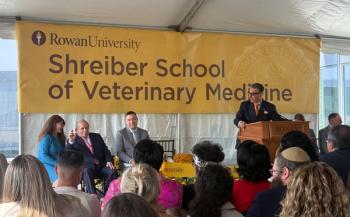
Equine examination (Proceedings)
Equine ocular examination is very similar to small animal examination, with special considerations for the size and use of the animal being examined.
Ocular Examination:
Equine ocular examination is very similar to small animal examination, with special considerations for the size and use of the animal being examined.
The first part of the examination would be a general examination, to include the general appearance and condition of the horse and its ability to maneuver on flat and uneven surfaces. A careful history should be elicited from the owner, and general observations should be made.
The order of examination is from the outside inward, ending up with retinal and neuro-ophthalmic examination.
When approaching the horse head-on, the symmetry of the eyes should be noted, and in particular, the position of the eyelids and lashes. Closer inspection of the periocular tissue would include the degree of condition and the amount of orbital fat, which has an effect on the position of the globe. The eyelids are then noted, to include the eyelid margins for any prior lacerations or breaks in the eyelid margin.
The conjunctivae of the third eyelid and the palpebrae are evaluated for hyperemia and chemosis. The puncta of the nasolacrimal system should be observed in the dorsal and ventronasal lid area. The corneae and the conjunctivae are then evaluated next, and the corneae should be evaluated for clarity, any coloration, and change in the smoothness of the surface; this requires bright focal illumination and is preferably performed in a darkened stall with magnification (a slit-lamp biomicroscope is the best instrument for this purpose). Next, we proceed into the eye to examine the anterior chamber for clarity and the absence of flare and cells in the aqueous humor. The iris surface is inspected for normal architecture, and the corpora nigra (granula iridica) is then evaluated, both on the dorsal and lower pupillary margin; atrophy of this may indicate prior inflammation, and cystic formation should be noted. The lens is best examined through a dilated pupil in dark surroundings. Short-acting mydriatic agents act for three to four hours, and the horse should not be ridden for that period of time following instillation of short-acting products. Atropine, as a warning, may last for up to two to three weeks in a horse and should only be used as a therapeutic agent. The lens is evaluated for clarity and any coloration changes, adhesions of iris-to-lens capsule, and pigment migration on the surface of the lens capsule. Intraocular pressures can then be evaluated by using one of the newer tonometry systems; both rebound tonometry or applanation tonometry are useful (Schiotz tonometry is impractical in a horse). Next, the posterior segment, to include the vitreous and the fundus, is examined; this will require either a direct ophthalmoscope or indirect ophthalmoscopy, which can be performed by a number of different techniques. The vitreous may be liquified or have clouding in older horses, or in horses with inflammation. Evaluation of the fundus should be systematic, and I typically recommend starting with the optic nerve and then evaluating each quadrant in a systematic fashion. The optic disc is typically pink-to-salmon-colored and has anywhere from 40-60 small arterioles and venules that emanate a short distance around the optic disc. The disc always lies in the nontapetal fundus dorsally. The tapetal fundus can be evaluated; it has a granular appearance and may have radiating, star-like color changes that have to do with capillary vessels within the tapetal and retinal area. The neuro-ophthalmic examination would include eyelid reflexes, menace response, and positional changes with movement of the head. Consensual pupillary light reflexes can be evaluated by one examiner shining a bright light in one eye and looking for the associated response in the other.
Diagnostic Techniques for the Equine:
Again, most of the techniques applied to the equine are those that come to us from human and small animal medicine; they include the more specific examination with magnification of biomicroscopy and direct and indirect ophthalmoscopy. Biomicroscopy can be simulated by using a slit beam, which is available on some direct ophthalmoscope heads, and using magnification. The slit beam comes at a slight angle to the area of magnification, and again, this is best performed in a dark stall; this helps to highlight any changes to the cornea, thickness, and surface continuity, along with flare and cells in the anterior chamber and a better appreciation of the iridal structures. Direct ophthalmoscope should be set at zero, depending on the examiner's correction, and viewed from one to two feet away, then come slowly towards the eye, through the dilated pupil, to the area of the optic disc, and then a systemic examination proceeds from there. The direct ophthalmoscope applies approximately 7-8X magnification of the posterior segment and is best used for evaluating changes in the optic disc and the peripapillary area. Indirect ophthalmoscopy is performed using a 14-20 diopter lens with a focal light source; this can be a Finoff transilluminator that is used on the direct ophthalmoscope power pack. A more elaborate system of a head-mounted unit is available from a number of suppliers; this level of magnification (actually minification) reduces the image size to approximately 0.8, depending on the diopter strength of the lens use. First, a fundic reflex is obtained with a Finoff transilluminator, and then the indirect lens is superimposed into the reflex approximately 5 cm in front of the horse's eye; this allows a more panoramic view, and again, once the optic nerve is located, a systemic evaluation of the fundus should be performed. Once lesions have been located by indirect ophthalmoscopy, it is nice to follow up with biomicroscopy. The order of other diagnostics should include obtaining specimen for bacterial or fungal culture and sensitivity, followed by cytology, followed by dye staining. Tonometry can be inserted, where appropriate, at any stage following obtaining of specimen for culture and sensitivity.
Culture and Sensitivity:
Culture and sensitivity specimens can be obtained by premoistening the swab to enhance results. Results should be sent to a diagnostic lab, and sensitivity selection should be based on medicines that are appropriate to use in the eye.
Cytology:
Cytological specimens can be collected by a variety of methods, but the best are Cytobrushes, which are designed specifically to collect exfoliative cytology. Once specimens have been obtained, and the eye has usually been previously anesthetized with topical anesthetic agents, they are applied to 3-5 microscopic slides; these should be processed for staining as soon as is practical. Bright Giemsa-type stains are appropriate for cytological evaluation, where specimens should be saved for special stains, including gram stains and fungal stains.
Opthalmic Stains:
A number of ophthalmic stains are available to help elucidate corneal and conjunctival disease; these include fluorescein dye stains, which are hydrophilic and are repelled by healthy corneal epithelium. Stain retention is noted when there is a break in the epithelium and the underlying stroma absorbs the stain; deep ulcers that are down to Descemet's membrane may not retain stain either. Another stain that is useful in the equine is Rose Bengal stain, referred to as a vital stain because it stains nonvital epithelial cells; this has been helpful in demonstrating early fungal keratitis. The order of stains, typically, is fluorescein followed by Rose Bengal. Instillation of the stain can either be directly, from strips, or the dyes can be suspended in artificial tears and "spritzed" into the eye with a tuberculin syringe, using the hub of a needle on the end of the syringe.
Tonometry::
Modern tonometry applies two techniques; one of flattening the cornea, referred to as applanation tonometry; and another technique of the bouncing of a tiny probe off of the surface of the eye, which is referred to as rebound tonometry. Both techniques are fairly accurate in estimating intraocular pressures in horses. Glaucoma is relatively undiagnosed because of the lack of tonometry being performed.
Nerve Blocks:
Nerve blocks aid in the examination of a horse once the general exam has been completed and the neuro-ophthalmic observations have been made. Nerve blocks involve either blocking the motor nerve or a branch of seven, which can be performed over the zygomatic arch area; this will be demonstrated in the presentation. Motor blocks can be made at four points around the eye, and this will also be demonstrated in the slide show.
Treatment MethodsS:
Various methods have been used to apply topical medicines to the eye; these include topical solutions, suspensions, and ointments that are applied directly to the eye, subpalpebral lavage systems, and subconjunctival injections. Antibiotics commonly used in the horse include chloramphenicol, aminoglycosides, and a variety of fluoroquinolones. Antifungal agents include miconazole, itraconazole, and voriconazole. Mydriatic agents are helpful, and they include tropicamide for diagnostics purposes and atropine for therapeutic purposes. Tropicamide comes only in solution, and atropine comes in drop and solution. Anesthetic agents include lidocaine and bupivacaine for the nerve blocks, with proparacaine and tetracaine for topical anesthesia. Anticollagenase products include EDTA and serum, which have an effect on the MMP system that exacerbates the corneal ulceration process.
Newsletter
From exam room tips to practice management insights, get trusted veterinary news delivered straight to your inbox—subscribe to dvm360.






